INTRODUCTION
In recent years, chicken has been extensively being used for human nutrition and protein supply. Due to fast growth, ease of feeding, using enclosed space, and supplying requisite materials of human body, broiler farming has special advantages. Thank to increasing demand for this product and fast growth of population, use of modern knowledge and suitable scientific and technical methods is crucial for managing chicken farms so that existing demand for this product in society can be met.
In this sense, improvement of efficiency and fruition can be pondered as one of the most effective methods to realize production development, because this development results in maximization of use of resources, human force, time, facilities, etc. as well as reduction of production costs, market development, increase of employment, and improvement of life criteria (Khazayee, 1998).
So, in this paper, owing to importance of this topic and available potentials in Golestan Province as to production of this product, influencing factors on technical efficiency of chicken farms of Bandar-Turkmen area was evaluated via random sampling from the city using 40 questionnaires. Then, technical efficiency of exploiters of the city was calculated and analyzed through DEA method using De ap Software package.
Literature review:
Various domestic and foreign studies have been done on technical efficiency by authors. Some foreign studies are as follows:
Hashemi-tabaar et al (2009) indicated allocated loans to fisheries sector of Sistan-Balouchestan Province and calculation of technical efficiency of exploiters of this sector in 2005. The results showed that the allocated loans to the exploiters of fisheries had a positive influence on efficiency and the mentioned exploiters are in economic part of production in use of resources.
Mousavi and Khalilian (2005) have evaluated the factors affecting technical efficiency of wheat farmers of Shahr-e-Kord City. In this study, technical efficiency of wheat farmers of 29 farms has been estimated within 1998 to 2004 via random frontier production function. The results show that the variables such as use of under pressure irrigation, educational activities, and size of farms have positive and significant effect on production efficiency.
In a study named "evaluation of economic efficiency of production cooperatives of Dasht-e-Ghalamroud, Mohammadi and Sadr-al-ashrafi (2005) estimated technical, allocating, and economic efficiencies of members and nonmembers of cooperatives in Qom Province through random frontier method and data envelopment analysis method. After studying the factors affecting efficiency of alfalfa farmers, they found that members of cooperative have higher mean technical efficiency than nonmembers.
In their study about efficiency of cotton farmers of Iran within 1997-1998 in 13 provinces via data envelopment analysis method, Faryadras et al (2002) showed that management and technical efficiencies of cotton farmers of majority of provinces are favorable, but, allocating and economic efficiencies of them are not that favorable and there is a big gap between these two efficiencies in various provinces.
Some foreign studies in this case are as follows:
In a study, Battese and Colli (1995) have evaluated efficiency of farmers in India. In this study, random frontier production function has been used in order to estimate efficiency. The results show a relationship between characteristics of farmers and level of production efficiency. For instance, their results have shown that there is a direct relationship between efficiency level and education level and also there is a negative relationship between age of the farmers and their efficiency level.
In their study named "technical and economic efficiency of agriculture cooperatives of Russia with evaluation of technical and allocating efficiency and lack of them among the mentioned cooperatives", Svetlov and Heckman (2005) have shown that 65-100 percent of lack of efficiencies among the studied cooperatives are because of lack of allocating efficiency, and, lack of technical efficiency is the most important reason of deficiency of cash (Svetlov and Heckman, 2005, 1-32).
MATERIALS AND METHODS
Technical efficiency in production means maximum possible production through use of special amount of production factors. To estimate this, first, production function should be efficient technically and be representative of maximum producible product from use of a special complex of various production factors and then, real production of exploiters should be compared with it.
Farrell, who first spoke about efficiency, divided efficiency into three groups, namely: technical, allocating, and economic. Technical efficiency shows maximum production which is attainable from a special amount of production factors. Allocating efficiency specifies a complex of production factors which has minimum cost for the unit. Economic efficiency, also, shows the ability of the unit to gain maximum possible profit according to price and levels of store which is resulted from multiplying technical efficiency by allocating efficiency.
Generally speaking, efficiency estimation methods are divided into two groups: parametric and nonparametric (soderbom, et al, 2004). Estimation of random frontier production function and data envelopment analysis (DEA) have special place among parametric and nonparametric methods, respectively. In this paper, DEA method has been used to estimate technical efficiency.
In data envelopment analysis method, the data related to stores and products of each unit are used to construct a nonparametric production frontier. In fact, in this form, all observations related to the units are placed onto this line or under it. So, efficiency of each unit is estimated in comparison with efficiency of other units. The models of data envelopment analysis can be product-aimed or store-aimed. In product aimed models, the goal is to obtain maximum product level considering a special amount of store. Covering level of product-aimed and store-aimed models can be included with fixed efficiency according to scale and/or variable efficiency to scale.
Fixed efficiency according to product-aimed scale model has been introduced by Charnes et al as follows:
Where Y is s*n matrix from products, X is a m*n matrix from stores, S is deficiency variables, λ is the weight, ε is Archimedes constant,

is a row vector with
1*s dimensions for products and 1*m dimensions for stores, and δ is a one-element matrix which is used as an additive to all products of unit.
DEA is a suitable method to estimate efficiency and the best advantage of this method, compared to frontier production function, is lack of a special presumption about form of production function and modulation of restriction to the model and also accepting the variable efficiency according to scale (Hjalmarsson et al, 2004).
RESULTS AND DISCCUSSION
The results of data envelopment analysis model estimation:
Efficiency results of chicken farmers in DEA with two presumption of fixed and variable efficiency to scale have been presented in table 1. The results show efficiency of chicken farmers in use of stores with minimum use of store for production of a special level of product (store-aimed).
Store-aimed method with fixed efficiency to scale:
Table 1 has presented the results related to efficiency of chicken farmers with presumption of fixed efficiency to scale. As it can be seen, the minimum and maximum technical efficiencies of chicken farmers are 0.76 and 100, respectively.
Table 1: distribution of technical efficiency of chicken farmers with fixed efficiency to scale
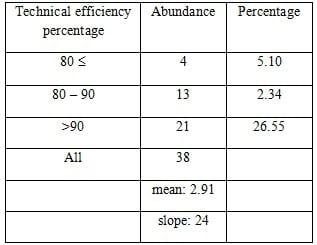 Resource: the results of the study
Resource: the results of the studyAs it can be seen, only 5.10 percent have efficiency lower than 80 percent, while, 26.55 percent have the efficiencies higher than 90 percent.
Store-aimed method with variable efficiency to scale:
In variable efficiency to scale method, the results show that technical efficiency of chicken farmers in the sample is variable between 5.76 and 100. Also, more than 63 percent of chicken farmers have efficiency higher than 90 percent.
Table 2: distribution of technical efficiency of chicken farmers with variable efficiency to scale
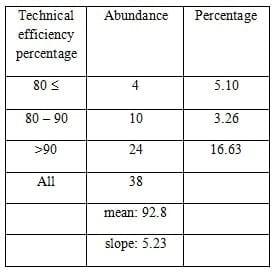 Resource: the results of the study
Resource: the results of the studyScale efficiency:
Considering the difference of technical efficiency in two methods with fixed and variable efficiency to scale, scale efficiency for each chicken farmer can be estimated through dividing technical efficiency in fixed efficiency to scale by technical efficiency with variable efficiency to scale (table 3). It can be seen that the mean scale efficiency of chicken farmers is 98.4 and slope of its changes in between 86.9 and 100.
Table 3: scale efficiency for the chicken farmers
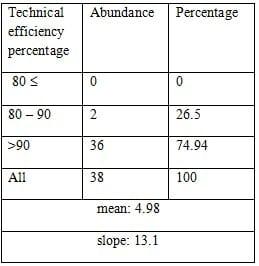 Resource: the results of the study
Resource: the results of the studyAlso, it can be seen that none of the units have decreasing efficiency to scale although around 32 percent of chicken farms have increasing efficiencies to scale. It means that through 1 percent simultaneous increase of stores, production in these units increases to more than 1 percent. Also, 4.68 percent of units have fixed efficiency to scale which shows that these units can increase their production despite the increase in all stores.
Table 4: efficiency to scale situation in the units
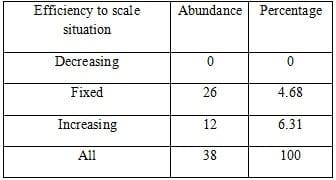 Resource: the results of the study
Resource: the results of the studyFinally, in this method, optimal amounts of use of each store have been presented for various chicken farms which can be seen in the following table.
Table 5: optimal amounts of stores for the chicken farms
Discussion and conclusion:
On the basis of the obtained results via data envelopment analysis, the mean efficiency of chicken farmers with fixed and variable efficiencies to scale have been estimated 91.2 and 92.8, respectively. Also, the results showed that the chicken farmers have 98.2 mean efficiencies to scale.
Finally, in order to elevate technical efficiency of chicken farmers, the following recommendations can be presented:
1- More attention to the relationship between young and experienced chicken farmers and transfer of experiences of successful and efficient chicken farmers to others;
2- Adoption of educational policies in order to improve technical knowledge and understanding of chicken farmers; and
3- Adoption of some policies about size of chicken farms in their optimal level.
References
1- خزائي، ش. (1377). بهرهوري آب كشاورزي در ايران، بهرهوري و كشاورزي (مقالات منتخب)،مؤسسه پژوهشهاي برنامهريزي و اقتصاد كشاورزي، 156-152.
2- فریادرس، و. ، امیرحسین چیذری و ابراهیم مرادی( 1381). اندازه گیری و مقایسه کارایی پنبه کاران ایران. فصلنامه اقتصاد کشاورزی و توسعه، سال دهم شماره 40.
3- محمدی، ه. و مهریار صدرالاشرافی،(1384). مطالعه کارایی اقتصادی تعاونی های تولید دشت قلمرود با استفاده از دو روش مرزی تصادفی و تحلیل فراگیر داده ها، مجله علوم کشاورزی، سال یازدهم، شماره 3.
4- موسوی، ح و صادق خلیلیان، (1384). بررسی عوامل اثرگذار بر کارایی فنی تولید گندم. مجله اقتصاد کشاورزی و توسعه، سال سیزدهم، شماره 52.
5- هاشمی تبار، م.، احمد اکبری، محمد حسین کریم و مهدی فرجامی فرد، (1388). تحلیل کارایی و آثار تسهیلات اعطا شده به بخش شیلات استان سیستان و بلوچستان، فصلنامه اقتصاد کشاورزی و توسعه، سال 17، شماره 65.
6- Alvarez, A .C and Arias (2003), Diseconomies of size with fixed managerial ability in dairy farms, American journal of agricultural economics. 85: 136-144.
7- Battese, G.E. and T.J.colli (1995). A model foe technical inefficiency effect in stochastic frontier production function for panel data, Empirical economics, 20: 325-332.
8- Charnes, A., Cooper, W. W. and Rhodes, E. 1978. Measuring the efficiency of decision making units. European Journal of Operations Research 2: 429-444.
9- Farrell, M.J. (1957), "The measurement of productive efficiency", Journal of the Royal Statistical Society A, 120: 253-281.
10- Greene, W.H. (1993), Econometric analysis, second edition, Pretice-Hall, Englewood Cliffs, New jersey, USA, 503-506.
11- Hjalmasson and et al (2004). Comparison DEA and SFA, Journal productivity analysis, 17:203-20.
12- Soderbom, M. and F. Teal (2004), Size and efficiency in African manufacturing firms: evidence from firm-level panel data, journal of development Economic, 73: 369-394.
13- Svetlov, N. Heckman, H. (2005), "Technical and economic efficiency of Russian Corporate farms: The case study of Moscow region", Institute of Agricultural Development in Central and Eastern Europe (IAMO), Discussion paper NO. 84
14- Wirat, K. (2001), Measurement of technical efficiency in Thai agricultural production, www.std.cpc.ku.ac.th.
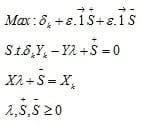





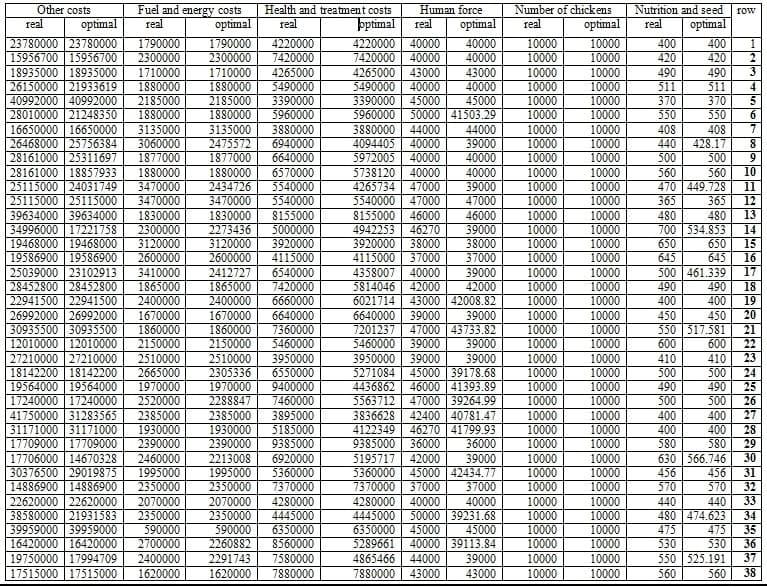













.jpg&w=3840&q=75)